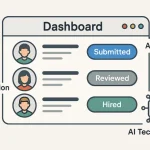Introduction
The recruitment landscape has been transformed by technology, enabling companies to attract, assess, and hire talent at a speed and scale never before possible. At the center of this evolution are Applicant Tracking Systems (ATS), software applications that automate and organize recruitment workflows from the moment a job is posted to the final hiring decision. Understanding what is applicant tracking system is crucial as organizations prioritize efficiency and accuracy in talent acquisition.
As today’s workforce diversifies and competition for talent intensifies, organizations need ATS platforms to handle growing applicant volumes while maintaining a positive candidate experience. These systems help companies manage recruitment processes by allowing hiring teams to collaborate, track each applicant’s journey, and ensure compliance with hiring regulations—all in one place. By leveraging ATS, businesses can significantly decrease their time-to-hire while increasing the likelihood of hiring the right candidates.
This rise in adoption is not limited to large enterprises; small and midsize businesses are also turning to ATS to gain a competitive edge in identifying qualified candidates quickly and efficiently. Modern ATS solutions are robust, intuitive, and scalable, enabling organizations of all sizes to integrate best practices into their hiring processes and remain agile in an ever-evolving market.
In addition to organizational advantages, Applicant Tracking Systems enhance the candidate experience. Automated communications, transparent applicant status updates, and easy-to-use application portals reduce job search friction and foster positive impressions of the employer brand. Implementing ATS leads to strategic benefits for everyone in the recruitment equation, making it an indispensable component of contemporary talent acquisition.
Your next favorite post is here—explore what connects it all.
The Rise of Applicant Tracking Systems
The transition from manual, paper-based hiring processes to digital, automated strategies has been dramatic. A decade ago, many organizations relied on email and spreadsheets, resulting in time-consuming workflows and a higher risk of errors or lost candidates. The widespread adoption of applicant tracking systems (ATS) has fundamentally shifted hiring dynamics, allowing recruiters and hiring managers to centralize data, automate routine tasks, and focus on building strong relationships with top talent. According to TechTarget, an ATS serves as the backbone of modern recruitment, helping organizations manage the entire hiring lifecycle efficiently.
Leading companies now view ATS as the foundation of their hiring infrastructure. These systems not only streamline job postings across multiple boards but also automate resume parsing, candidate ranking, interview scheduling, and communication, ensuring a consistent, compliant process. This level of automation empowers recruiters to spend more time on strategic initiatives such as employer branding and talent nurturing, rather than on administrative chores.
AI Integration: Enhancing Efficiency and Accuracy
Artificial Intelligence is rapidly becoming a game-changer in the world of ATS. AI-powered platforms harness machine learning algorithms to screen resumes beyond mere keyword matching, identifying the most qualified candidates by understanding both context and intent. These intelligent systems can interpret nuances in job descriptions and candidate profiles, flagging applicants who possess the necessary blend of hard and soft skills, and even predicting future job performance by analyzing historical data.
Some platforms use AI-driven chatbots to engage candidates immediately upon application, answering questions, providing status updates, and keeping applicants informed throughout the process. Predictive analytics, another breakthrough powered by AI, forecasts trends such as candidate drop-off rates or the likelihood of a successful hire, allowing recruitment teams to optimize every stage of the hiring funnel. The impact is profound: companies see reduced hiring bias, fewer bottlenecks, and much faster turnaround times on crucial roles.
Mobile-Friendly Interfaces: Accessible Recruitment on the Go
With the ubiquity of smartphones, candidates increasingly expect a seamless, mobile-first application experience. Modern ATS platforms prioritize responsive design, enabling job seekers to search for jobs, upload resumes, and communicate with hiring teams from any device. Mobile-friendly career portals and recruiter dashboards also offer convenience for busy talent acquisition professionals who are frequently on the move.
This shift to mobile is not merely a feature—it’s essential for reaching wider talent pools and providing an inclusive hiring process. Mobile optimization helps organizations tap into passive talent, who may only have time for preliminary job searches during commutes or lunch breaks, and ensures no candidate is left behind due to technological limitations. More than ever, mobile accessibility is a key differentiator in employer branding and recruiter productivity.
Video Interviewing: A Personalized Approach to Candidate Assessment
Video interviewing features have become integral to Applicant Tracking Systems, especially in remote-first or geographically diverse organizations. Through pre-recorded or live video interactions, recruiters evaluate communication skills, problem-solving abilities, and cultural fit in a manner that’s often more telling than written applications alone. This format also gives candidates the opportunity to showcase personality and motivation, factors that are increasingly important in team-based or client-facing roles. According to Forbes, leveraging video interviewing effectively can significantly improve hiring outcomes by providing structured, consistent insights that go beyond resumes and cover letters.
For recruiters, video interviews shorten the scheduling process and facilitate consistent evaluation criteria, improving both efficiency and fairness. ATS-integrated video tools also enable automated sharing and team-based assessments, so multiple decision-makers can review and score interviews asynchronously. As hiring moves toward personalization and agility, video interviewing continues to bridge gaps in global talent pools and enhance the overall recruitment process.
Data Analytics: Driving Informed Hiring Decisions
The use of analytics within ATS enables organizations to gain actionable insights from every step of the recruitment journey. By examining key performance indicators—such as time-to-fill, quality-of-hire, source effectiveness, and candidate conversion rates—companies can identify what’s working and what needs improvement. These data-driven insights enable continuous optimization, resulting in more effective hiring outcomes and minimizing wasted resources.
Modern ATS platforms increasingly include customizable dashboards and real-time reporting, empowering recruiters to spot bottlenecks and disparities and make adjustments proactively. Leveraging these analytics results enables better workforce planning, more effective allocation of recruiting budgets, and more substantial alignment between hiring goals and organizational objectives.
Future Trends in Applicant Tracking Systems
- AI-Driven Personalization: The next generation of ATS will leverage advanced AI tools to deliver highly personalized candidate experiences, including tailored job matches, automated scheduling based on availability, and bespoke communications that engage talent more effectively than ever before.
- Seamless Integration with HR Technologies: Future ATS solutions will connect more deeply with other core HR systems—ranging from onboarding and learning management platforms to employee engagement tools—enabling holistic talent management from recruitment through retention.
- Enhanced Mobile Optimization: With workforces embracing flexible, remote, and on-the-go work styles, mobile-first recruiting will become a primary standard, making every part of the hiring journey, for both candidates and recruiters, accessible and efficient on mobile devices.
Organizations investing in these future-ready technologies will find themselves better equipped to navigate the complexities of tomorrow’s competitive talent landscape, ensuring a superior pipeline of future hires and a stronger, data-driven recruitment function.
Conclusion
Applicant Tracking Systems have redefined how companies attract, engage, and hire talent, serving as the backbone of modern recruitment. By embracing innovations such as AI-powered resume screening, mobile-optimized interfaces, integrated video interviewing, and robust analytics, organizations can secure better hires faster and deliver superior experiences for candidates and recruiting teams alike. Adapting to—and investing in—these trends will be vital for organizations striving to stay ahead of the curve and build world-class teams for the future.
Keep exploring—there’s always more to learn, love, and share.







